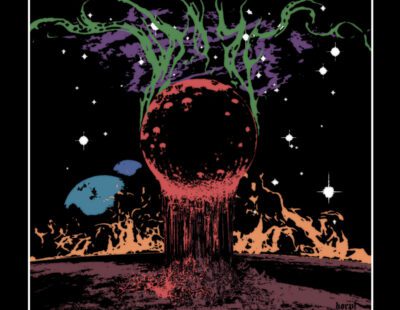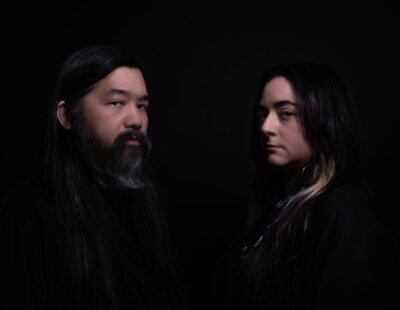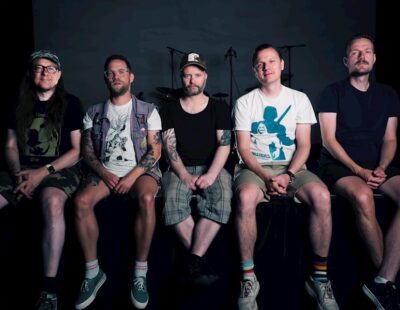
Just like the subterranean roots on Entombed’s Clandestine cover, Dan Seagrave‘s art is intricately tangled with the history of death metal. But while headbangers may know Seagrave primarily for his Suffocation or Morbid Angel covers – or his self-referential piece for Albert Mudrian’s Choosing Death – the scope of his artwork extends past extremely extreme music. On September 17th, Eridanos Tattoo & Art Gallery (in Cambridge, MA) will host an opportunity to explore Seagrave’s art further with an opening reception for his “Migrators” series.
Eridanos owner/artist mark Blanchard confirms his staff “is active in the heavier music realm.” So it’s no surprise that this is actually Seagrave’s second exhibition at Eridanos, following an art show focused on artists within the metal community called Path of Dissent. When asked about Seagrave’s “Migrators” series and why it appealed to him, Blanchard countered, “Aside from all of us being Seagrave fans and his series mission statement blowing our minds?”
After the otherworldly samples from his series shared below, Dan Seagrave explains the history of “Migrators” and ruminates on his favorite tattoo homages to his own artwork. But first, here’s Seagrave’s artist statement, so prepare your skull for imminent explosion:
Dan Seagrave: “Within evolution there suggests the idea of a creator. One that rejects, or abandons ill suited forms. And so we have the Migrators. Existing perhaps as Meta forms from an implausible sub linear strand of evolutionary rejection. The ghost of an idea. These drifting elementals display their corrupted malformed shapes as if mineralized by eons of time. Such as might be seen in a scattered fossil record. Each one a unique rejection of evolution. Gathering atomic data inconsequentially. Transience and illegitimacy becomes their function. In a functionless void.”





When did you create your first piece in the “Migrators” series? Did you picture it becoming part of a larger series the whole time, or originally as a one-off creation?
Dan Seagrave: “I’d been doodling these moth-type images for some time, probably from around 2006, and at that same time I was making a short film back in Nottingham for The UK film council. That film, called Shadowline, ended up having a certain underlining use of these images. [They] can be seen throughout the footage; for example, in the notebook that the lead character discovers, a book of names with various moth shapes, or instar sketches – the instar being the cocoon stage prior to its transformation into the moth. The idea there was to suggest that the character was trapped in a kind of psychological cocoon or instar, but was unable to develop and escape and shed the past. Instead, [the character] was doomed to fester in his stifled and repressed existence for all time. I had made a winter’s trip back to Toronto just before this and also made the first painting titled “Instar” after someone asked me to participate in a group show, so these images were in my mind. That first artwork was later used by Entombed for their single “Amok.”
“I later made another similar symmetrical artwork back in the UK while taking a course in late 2007. So the beginnings were kind of slow and patchy. It hadn’t really occurred to me that i was going to make a series out of the idea, and I guess I was busy with a number of other things besides painting for that year. So then it went silent for a while. I think the symmetrical version of it became a little off-putting, so it wasn’t until 2012 when I realized I was doodling winged creatures again, and they were becoming very abstracted, that i got really interested in painting those forms. I think what made it come alive was the freedom to paint what appeared to be an animal form, but allow myself to not be burdened by the laws of nature, or caring too much about presenting something that looks ‘right’ as an animal form, or for it to be a moth, or a bird, etc. Rather they became sort of bastardized distorted lifeforms. They took on individual character, and the idea for them grew simultaneously with each painting. Initially just letting the work come to fruition without imposing or enforcing too great a structure, or intent. So gradually the work came to become a series, without the pressure of it needing to be for any purpose or display.”
Apart from being an art gallery, Eridanos is also home to renown tattoo artists. What’s the most memorable tattoo a fan has shown you that was attempting to replicate your work?
Seagrave: That kind of experience is more recent for me, as I’ve only been participating in festivals or expos since 2013. Up until then, I had no encounters in the everyday world. So in those situations, there have been a few people who will show me their tattoos incorporating an artwork I did. At MDF 2015, a lady had part of Suffocation’s Effigy of the Forgotten on her arm. That was pretty cool. And at MDF 2016, a guy showed me the his tattoo of of the entire Altars of Madness, which was fully replicated off to one side of the gut. It looked full-scale vinyl size. That was a decent rendering. I’d like to see if someone did a full Clandestine rendering.
Follow the details on this Facebook event, then head out to Eridanos and meet the Migrators in person. On the way, bombard Decibel‘s social media with photographs of your Seagrave-inspired tattoos.






